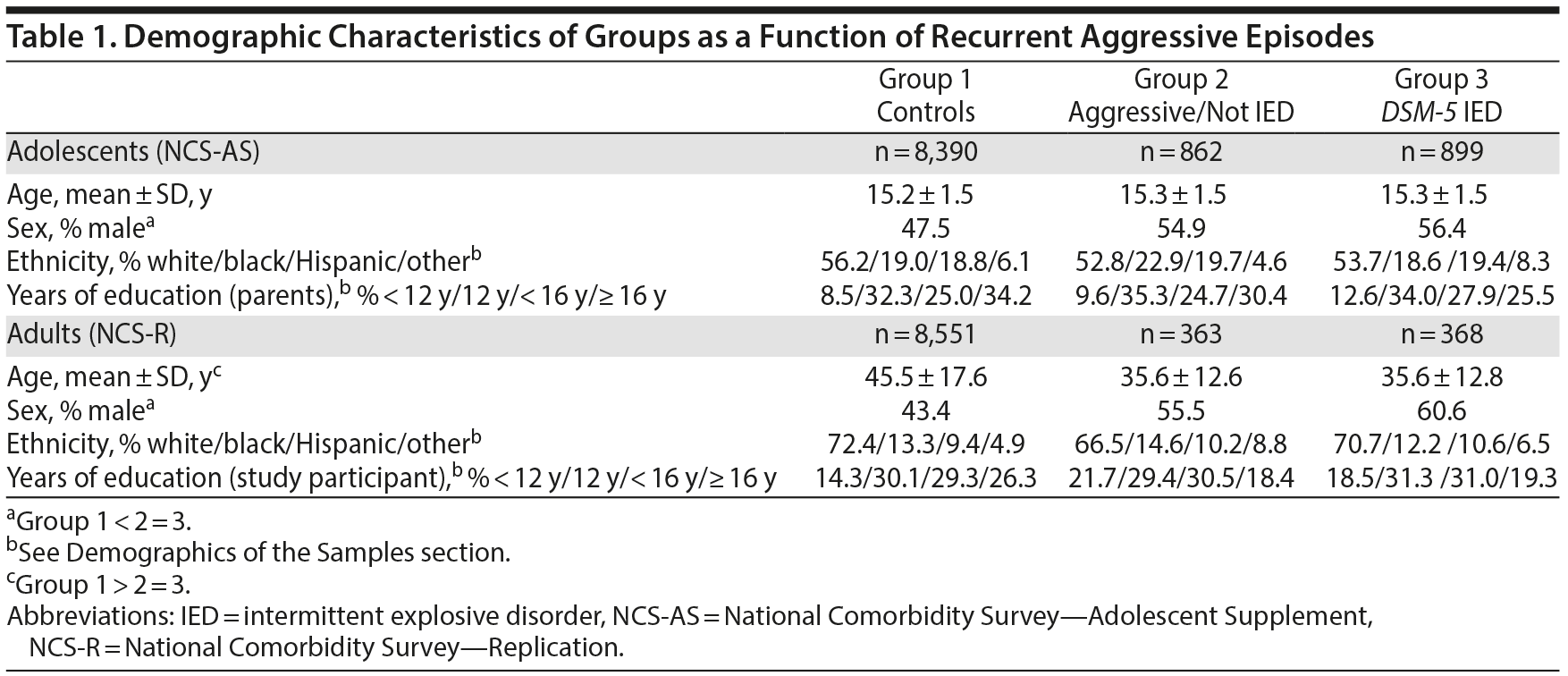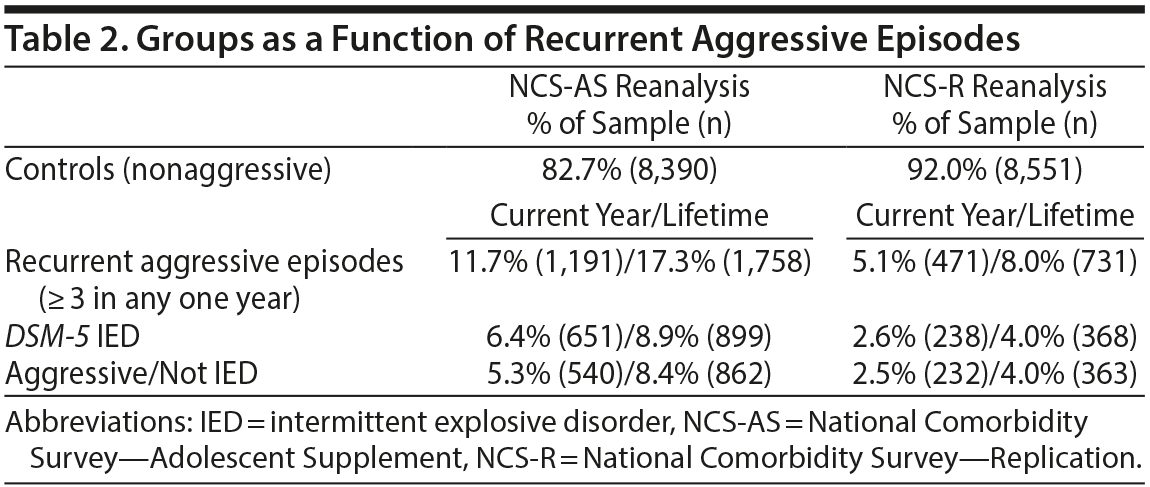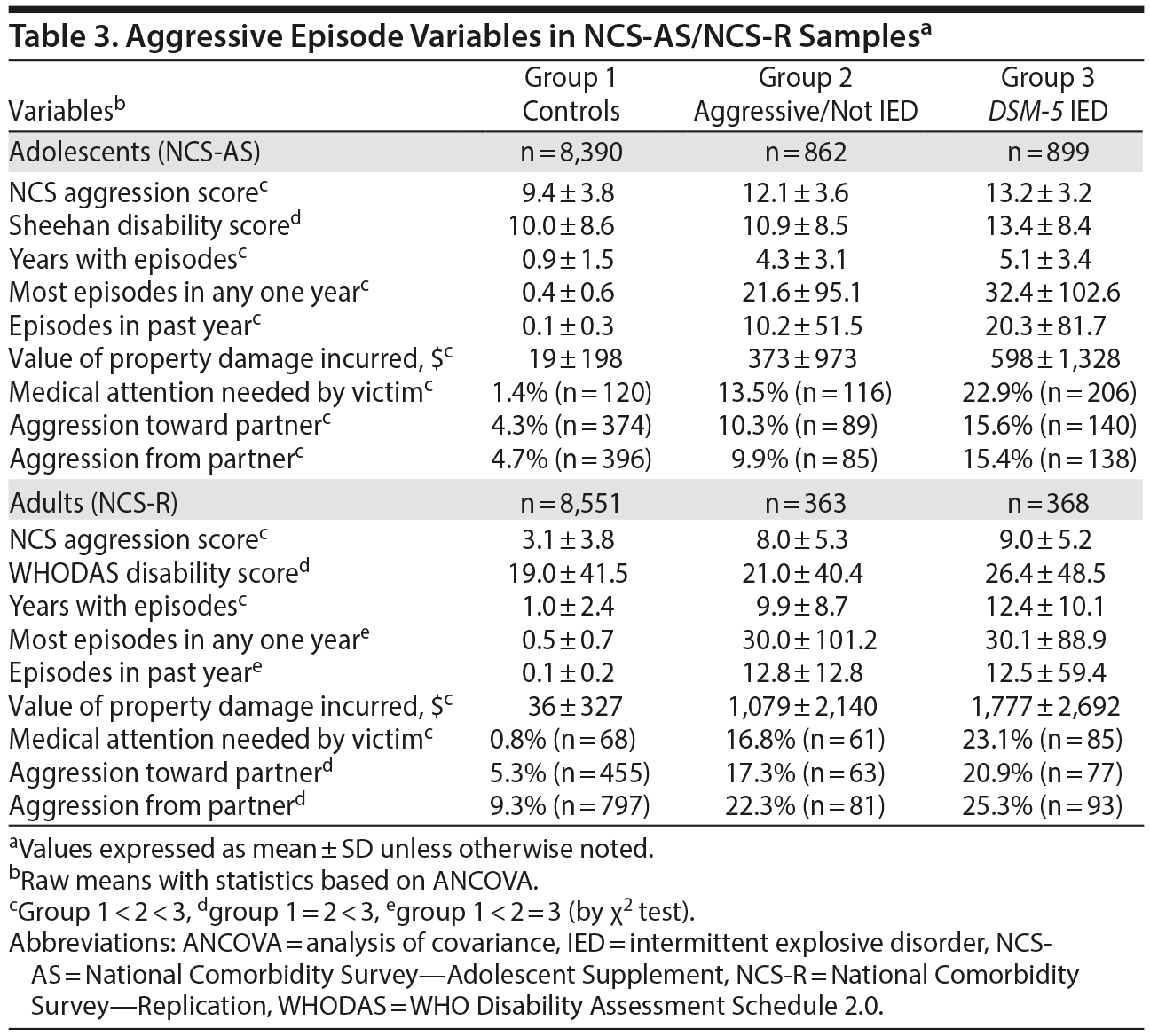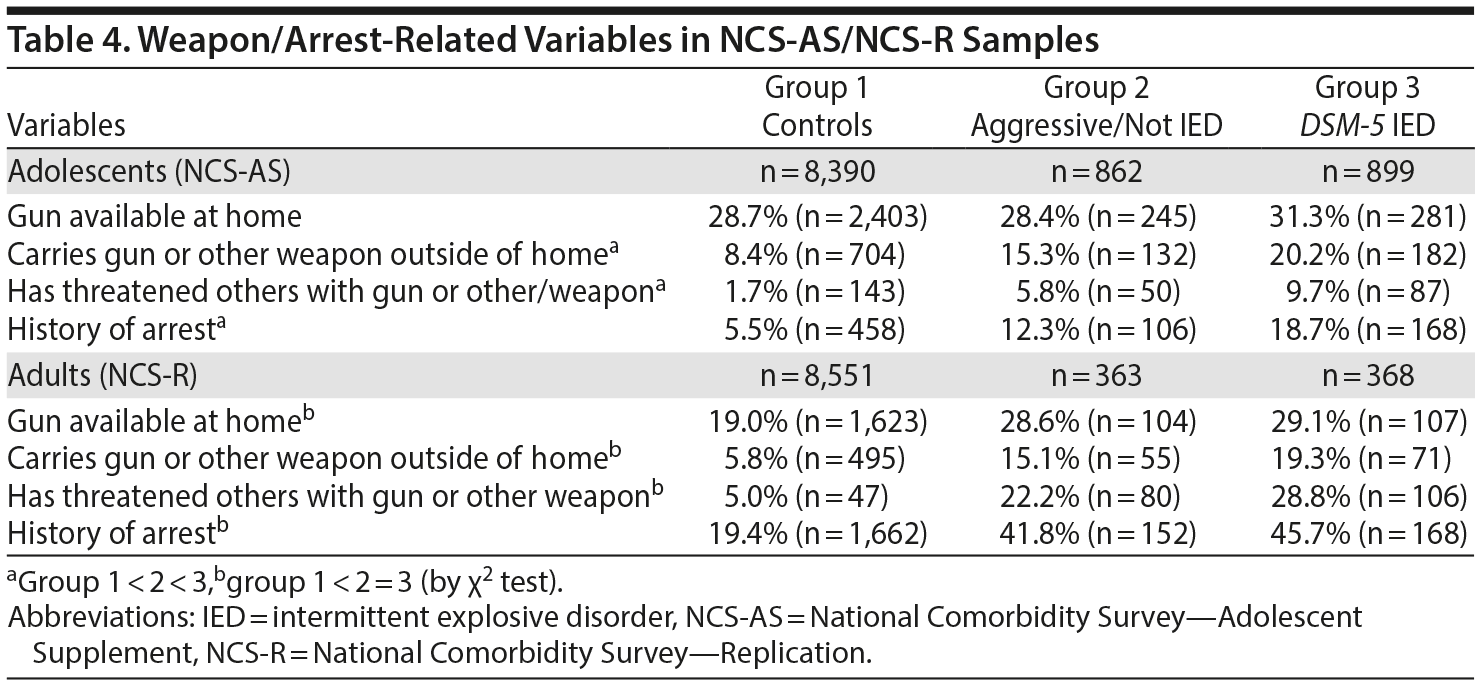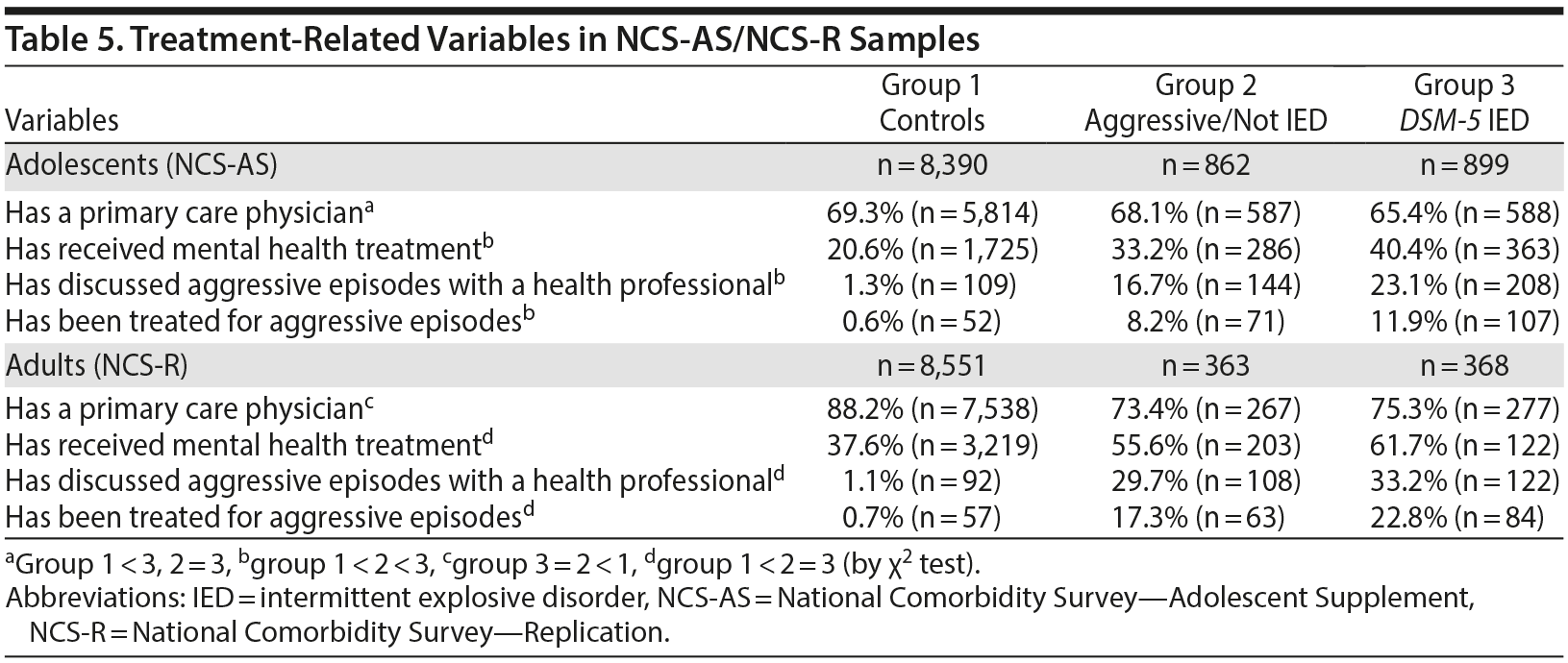Objective: To determine the prevalence and correlates of DSM-5 intermittent explosive disorder and related aggressive disorders in the United States.
Methods: Community survey data (collected between 2001-2004) from the National Comorbidity Survey—Replication (NCS-R) and Adolescent Supplement (NCS-AS) involving 10,148 adolescents and 9,282 adults, respectively, were reanalyzed with recurrent aggressive behavior defined as 3 serious aggressive outbursts in any given year. In addition to prevalence, assessments of aggression severity, property damage, injury to others, intimate partner assault, utilization of guns and weapons to threaten, and treatment utilization for recurrent aggressive behavior were also assessed.
Results: About 17% of adolescents and 8% of adults report a pattern of recurrent aggressive outbursts within at least 1 year. Such individuals are much more aggressive and impulsive than nonaggressive controls and are more likely to engage in intimate partner assault, carry and use guns and other weapons to threaten others, and be arrested by law enforcement. Few aggressive individuals speak with health care providers about this behavior, and fewer receive treatment for aggression.
Conclusion: Recurrent aggressive behavior is common in both adolescents and adults, with clinically significant consequences to those with this pattern and to others in their environment (ie, using guns and other weapons to threaten others). While this type of behavior can be reduced though pharmacologic/psychosocial treatment intervention, the vast majority of aggressive individuals do not engage in treatment for their aggressive behavior. Screening individuals for such behavior in one’s practice may do much toward identifying this problem and bringing such individuals into treatment.
This work may not be copied, distributed, displayed, published, reproduced, transmitted, modified, posted, sold, licensed, or used for commercial purposes. By downloading this file, you are agreeing to the publisher’s Terms & Conditions.

CME Background
Articles are selected for credit designation based on an assessment of the educational needs of CME participants, with the purpose of providing readers with a curriculum of CME articles on a variety of topics throughout each volume. Activities are planned using a process that links identified needs with desired results.
To obtain credit, read the article, correctly answer the questions in the Posttest, and complete the Evaluation. A $10 processing fee will apply.
CME Objective
After studying this article, you should be able to:
‘ ¢Screen patients for recurrent impulsive aggression and intermittent explosive disorder so that they can be treated if diagnosed
Accreditation Statement
The CME Institute of Physicians Postgraduate Press, Inc., is accredited by the Accreditation Council for Continuing Medical Education to provide continuing medical education for physicians.
Credit Designation
The CME Institute of Physicians Postgraduate Press, Inc., designates this journal-based CME activity for a maximum of 1 AMA PRA Category 1 Creditâ„¢. Physicians should claim only the credit commensurate with the extent of their participation in the activity.
Note: The American Academy of Physician Assistants (AAPA) accepts certificates of participation for educational activities certified for AMA PRA Category 1 Creditâ„¢ from organizations accredited by ACCME or a recognized state medical society. Physician assistants may receive a maximum of 1 hour of Category I credit for completing this program.
Release, Expiration, and Review Dates
This educational activity was published in March 2020 and is eligible for AMA PRA Category 1 Creditâ„¢ through April 30, 2022. The latest review of this material was February 2020.
Financial Disclosure
All individuals in a position to influence the content of this activity were asked to complete a statement regarding all relevant personal financial relationships between themselves or their spouse/partner and any commercial interest. The CME Institute has resolved any conflicts of interest that were identified. In the past year, Marlene P. Freeman, MD, Editor in Chief, has received research funding from JayMac and Sage; has been a member of the advisory boards for Otsuka, Alkermes, and Sunovion; has been a member of the Independent Data Safety and Monitoring Committee for Janssen; has been a member of the Steering Committee for Educational Activities for Medscape; and, as a Massachusetts General Hospital (MGH) employee, works with the MGH National Pregnancy Registry, which is sponsored by Teva, Alkermes, Otsuka, Actavis, and Sunovion, and works with the MGH Clinical Trials Network and Institute, which receives research funding from multiple pharmaceutical companies and the National Institute of Mental Health. No member of the CME Institute staff reported any relevant personal financial relationships. Faculty financial disclosure appears at the end of the article.
This CME activity is expired. For more CME activities, visit cme.psychiatrist.com.
Find more articles on this and other psychiatry and CNS topics:
The Journal of Clinical Psychiatry
The Primary Care Companion for CNS Disorders
ABSTRACT
Objective: To determine the prevalence and correlates of DSM-5 intermittent explosive disorder and related aggressive disorders in the United States.
Methods: Community survey data (collected between 2001-2004) from the National Comorbidity Survey—Replication (NCS-R) and Adolescent Supplement (NCS-AS) involving 10,148 adolescents and 9,282 adults, respectively, were reanalyzed with recurrent aggressive behavior defined as 3 serious aggressive outbursts in any given year. In addition to prevalence, assessments of aggression severity, property damage, injury to others, intimate partner assault, utilization of guns and weapons to threaten, and treatment utilization for recurrent aggressive behavior were also assessed.
Results: About 17% of adolescents and 8% of adults report a pattern of recurrent aggressive outbursts within at least 1 year. Such individuals are much more aggressive and impulsive than nonaggressive controls and are more likely to engage in intimate partner assault, carry and use guns and other weapons to threaten others, and be arrested by law enforcement. Few aggressive individuals speak with health care providers about this behavior, and fewer receive treatment for aggression.
Conclusion: Recurrent aggressive behavior is common in both adolescents and adults, with clinically significant consequences to those with this pattern and to others in their environment (ie, using guns and other weapons to threaten others). While this type of behavior can be reduced though pharmacologic/psychosocial treatment intervention, the vast majority of aggressive individuals do not engage in treatment for their aggressive behavior. Screening individuals for such behavior in one’s practice may do much toward identifying this problem and bringing such individuals into treatment.
J Clin Psychiatry 2020;81(2):19m12937
To cite: Coccaro EF, Lee RJ. Disordered aggression and violence in the United States. J Clin Psychiatry. 2020;81(2):19m12937.
To share: https://doi.org/10.4088/JCP.19m12937
© Copyright 2020 Physicians Postgraduate Press, Inc.
aClinical Neuroscience Research Unit, Department of Psychiatry and Behavioral Neuroscience, Pritzker School of Medicine, The University of Chicago, Chicago, Illinois
‡As of May 2020, Dr Coccaro will be affiliated with the Clinical Neuroscience Research Unit, Department of Psychiatry and Behavioral Neuroscience, Pritzker School of Medicine, The University of Chicago, Chicago, Illinois.
*Corresponding author: Emil F. Coccaro, MD, Clinical Neuroscience Research Unit, Department of Psychiatry and Behavioral Neuroscience, University of Chicago, 5841 South Maryland Ave, Chicago, IL 60637 ([email protected])
Violence is a critical public health issue in society. The 3 leading causes of death in the United States for people ages 15-34 years are unintentional injury, suicide, and homicide.1 Homicide is the leading cause of death for young, non-Hispanic black individuals,1 and firearms are implicated in the majority of these deaths.2 Violent victimization is common in the United States, with 51.9% of women and 66.4% of surveyed men reporting at least 1 lifetime physical assault.3
In recognition of violence worldwide, the World Health Organization (WHO) reframed it as a public health problem4 and proposed 4 principal recommendations for preventing it: (a) surveillance of the population, (b) understanding relevant risk and protective factors, (c) testing strategies to modify these risk and protective factors, and (d) facilitating dissemination of these strategies.5
Notably, the public health approach has emphasized many relevant factors for violence, including mental illness. Nonetheless, our understanding of the relationship between mental illness and violence remains incomplete. Not all mental illnesses increase violence risk.6 Some that do, such as schizophrenia, are associated with only a small increase in violence risk, largely in the context of a history of aggressive behavior in general7 or substance abuse.8 A synergistic effect of substance use on violence risk is actually strongest for those with personality disorder, rather than schizophrenia or bipolar disorder.9 Overall, previously identified linkages between mental illness and violence follow a complicated path often defined by comorbidity relationships among disorders. This complexity is problematic because the general presence of psychiatric disorder does not clearly predict who is at greatest violence risk.
Violence is a social and political term describing the end result of a range of destructive, interpersonal actions, many of which occur outside of the clinical realm. Aggression describes intentional actions or psychological states to repel, coerce, assault, or intimidate another person or animal.10 It occurs on a continuum of adaptive to maladaptive forms that includes socially sanctioned aggression (eg, soldiers in combat), medically induced aggression (eg, by central nervous system pathology), premeditated aggression (eg, aggression in the service of a tangible goal), and impulsive aggression (eg, aggression in the context of social threat or frustration). The link between mental illness and aggression has been established by a wealth of research. Two psychiatric disorders that include aggressive behavior as diagnostic criteria include conduct disorder and antisocial personality disorder. Conduct disorder describes a range of rule-breaking and aggressive behaviors in a maladaptive developmental context, with an estimated prevalence of 9.5% in the National Comorbidity Study dataset.11 Latent class analysis, however, revealed considerable heterogeneity within conduct disorder with regard to aggressive behavior. Four subtypes of conduct disorder were found: rule violation, deceitfulness/theft, aggression against people and animals, and a combined subtype. Notably, the aggressive subtype was the least prevalent, with only 3.2% of those with lifetime conduct disorder belonging to this class. Thus, while conduct disorder is an important description of dissocial behavior, particularly in children and adolescents, evidence indicates that it does not specifically capture aggressive behavior and likely accounts for only a small portion of aggression in society. Antisocial personality disorder (ASPD) has a lifetime prevalence of approximately 1%.12 Interpersonal aggression is accounted for in only 2 of 7 criteria of ASPD. Furthermore, persons with ASPD are 21 times more likely to develop alcohol use disorders, which are independently and strongly linked to violence.13 With the recent revision of the Diagnostic and Statistical Manual of Mental Disorders, Fifth Edition (DSM-5),14 the diagnosis of intermittent explosive disorder (IED) was revised and refined to represent a disorder of recurrent, problematic, impulsive (vs premeditated) aggressive behavior.12 Previously, the diagnostic criteria for IED were poorly operationalized. Those diagnostic criteria did not define the nature (ie, impulsive vs premeditated), did not define the frequency/duration of the aggressive behavior, and included many disorders whose presence would rule out the diagnosis of IED, largely making it a disorder of exclusion.15 Thus, the DSM-5 revision of IED criteria provides a new opportunity to examine the link between mental illness, recurrent aggression, and public health.
In this report, population-based data from the National Comorbidity Surveys16,17 were reanalyzed to estimate the prevalence and nature of aggressive disorders in the United States among both adolescents and adults.
METHODS
Study Samples
Cross-sectional data from 2 community samples (National Comorbidity Survey—Adolescent Supplement16 [NCS-AS; n = 10,148] and the National Comorbidity Survey—Replication17 [NCS-R; n = 9,282]) were reanalyzed. Analysis of these deidentified, public access data was exempt from review by a local institutional review board. NCS-AS and NCS-R are nationally representative surveys of the prevalence and correlates of mental disorders in the United States. Fully structured and laptop computer-assisted interviews were administered face-to-face to a sample of adolescents (NCS-AS) and adults (NCS-R) who were English-speaking and living in the noninstitutionalized civilian household population of the coterminous United States (excluding Alaska and Hawaii) between 2001 and 2004. Details regarding the design and acquisition of the 2 NCS-R samples have been published.16,17
Diagnoses by DSM-5
While both surveys were designed to assign DSM-IV diagnoses,18 raw survey data enabled an updating of DSM-IV to DSM-514 diagnoses. For DSM-5 IED, participants reported at least 3 aggressive episodes in any given year (criterion A2). While DSM-5 criteria also allow frequent, though low-intensity, aggressive episodes (criterion A1), neither survey included questions that allowed for the assessment of these types of aggressive episodes. In addition, aggressive episodes were out of proportion to the circumstances in which they occurred (criterion B), impulsive/anger-based in nature (criterion C), associated with functional impairment and/or distress (criterion D), and not better explained by other factors or other psychiatric disorders (criterion F); finally, all participants were at least 6 years of age (criterion E).
Dimensional Assessment of Traits of Aggression and Impulsivity
Both surveys included questions regarding dimensions of personality (45 items for NCS-AS; 44 items for NCS-R), some of which were relevant to IED (ie, aggression and/or impulsivity). In each community sample, 6 items were relevant to IED (eg, aggression [eg, “When I’ m angry with people I let them know”] and impulsivity [eg, “Giving into urges gets me into trouble”]), allowing the creation of an NCS aggression variable (α = 0.73 for NCS-AS; α = 0.68 for NCS-R). Scoring differed between the 2 surveys because NCS-AS items had 4 anchor points (0, 1, 2, 3) while NCS-R items had only 2 (0 or 3).
Assessment of Functional Disability
Disability was assessed with the Sheehan Disability Scale19 (SDS) in the NCS-AS and by the WHO Disability Assessment Schedule 2.020 in the NCS-R.
Severity of Aggressive Episodes
The variables related to severity of recurrent aggressive episodes included number of years in which 3 or more aggressive episodes occurred, greatest number of aggressive episodes in any year, number of episodes in the past year, value of property damage, and frequency of physical assault leading to medical attention for the assault victim.
Use of Guns and Other Weapons, Intimate Partner Assault, and History of Arrest

- Aggression is a public health problem that accounts for a significant portion of violence in society. Eight percent of US adults have recurrent aggression.
- These individuals are more likely to engage in intimate partner assault, carry guns and other weapons, and be arrested.
- Most of these individuals do not speak to health care providers about their aggressive history.
- Race is not a significant predictor of aggressive behavior.
These relevant variables were assessed by 6 true/false items related to history of (a) availability of a gun at home, (b) carrying a gun or other weapon outside the home, (c) threatening others with a gun or other weapon, (d) assaulting an intimate partner, (e) assault by an intimate partner, and (f) arrest by law enforcement for any reason.
Variables Related to Treatment
Treatment-related variables included the frequency of study participants reporting that they (a) have a primary physician for health care, (b) received psychiatric care for emotional issues in general, (c) discussed aggressive behavior with a health care professional, and (d) received treatment for their aggressive behavior.
Statistical Analysis
Study participants were divided into 3 groups as a function of having at least 3 aggressive episodes in any one year (the yearly rate defined for serious aggressive behavior for the A2 criterion in the DSM-5): (a) participants who met lifetime criteria for DSM-5 IED; (b) participants who had 3 aggressive episodes in any one year but did not fulfill criteria for DSM-5 IED (Aggressive/Not IED) because they denied presence of anger dyscontrol, because they denied subjective distress or functional impairment due to aggression, or because another factor better explained aggressive episodes; and (c) participants with fewer than 3 aggressive episodes in any year (Controls). Statistical procedures included χ2, analysis of variance and analysis of covariance, and binary logistic regression for adjusted odds ratios (ORs) as appropriate. All reported data were adjusted for age, sex, ethnicity, and education (level of parental education for NCS-AS; level of each adult participant for NCS-R). A 2-tailed α of 0.05 was used to denote statistical significance for all analyses with Bonferroni correction for multiple testing.
RESULTS
Demographics of the Samples
For the adolescent sample, Control, Aggressive/Not IED, and DSM-5 IED groups were similar in mean age but differed in proportions of sex, ethnicity, and education level of parents (Table 1). The two aggressive groups had a greater proportion of males and less education among the parents. Race was not associated with aggression after accounting for socioeconomic status. For the adult sample, individuals in the aggressive groups were significantly younger, more often male, and less educated.
Recurrent Aggressive Episodes
The vast majority of adolescents (82.7%) reported fewer than 3 aggressive episodes in any single year, with half the sample (52.9%) reporting no aggressive episodes in any year and 24.1% and 5.6%, respectively, reporting no more than 1 or 2 episodes in any single year (Table 2). The remainder (17.3%) reported 3 or more aggressive episodes in any single year, with about equal proportions meeting (8.9%) and not meeting (8.4%) DSM-5 criteria for IED. Similar results were observed in the adult sample: 92.0% of adults reported fewer than 3 aggressive episodes in any year, with more than half the adults (63.3%) reporting no aggressive episodes in any given year and 21.3% and 15.5%, respectively, reporting no more than 1 or 2 episodes in any year. The remainder (8.0%) reported 3 or more aggressive episodes in any year, with equal proportions meeting (4.0%) and not meeting (4.0%) DSM-5 criteria for IED.
Recurrent Aggressive Behavior as a Function of Related Behavioral Variables
Mean NCS aggression scores followed a significant stepwise increase from Controls to Aggressive/Not IED to DSM-5 IED in the adolescent sample (Table 3). The same was true for the number of years in which aggressive episodes took place, number of most aggressive episodes in any one year, number of episodes in the past year, value of property destruction, likelihood of medical attention needed by the victim of assault, and likelihood of assaulting, or being assaulted by, an intimate partner. SDS Disability scores were higher in Aggressive/Not IED and DSM-5 IED compared with control participants, but these 2 groups did not differ from each other. In adults, Aggressive/No IED and DSM-5 IED study participants differed in the same way as adolescents when compared with controls but did not differ on most other related variables.
Instruments of Aggression, History of Intimate Partner Violence, and Arrest as a Function of Recurrent Aggressive Behavior
The likelihood of adolescents reporting that a gun was available at home (all had access at home to other weapons such as knives) was similar in all 3 groups (Table 4). However, the likelihood that adolescents reported carrying a gun/other weapon outside the home, history of threatening others with a gun/other weapon, or history of criminal arrest increased in a significant stepwise manner across the 3 groups. For adults, the proportion of those reporting availability of a gun at home, carrying a gun/other weapon outside the home, threatening others with a gun or other weapon, and history of intimate partner violence and criminal arrest was significantly greater for both aggressive groups compared with controls.
Treatment Seeking/Engagement as a Function of Recurrent Aggressive Episodes
The majority of study participants in both samples reported they had a primary physician for medical care, with those in either aggression category significantly less likely to report availability of a primary physician (Table 5). Together, aggressive participants were more likely than controls to report a history of psychiatric treatment, report a history of speaking with a professional, and receive treatment for their aggressive behavior. Within the aggressive group, a significant stepwise reduction was observed in both samples with respect to the odds ratios comparing reported history of psychiatric treatment with reported discussion of aggressive behavior with a health care professional to reported history of treatment for aggression (adolescents: OR = 0.43 [0.37-0.50] to 0.19 [0.16-0.23]; adults: OR = 0.32 [0.26-0.40] to 0.18 [0.14-0.22]). The time between speaking with a professional and getting treatment for aggression in the adolescent sample, when this occurred, was 0.6 ± 1.6 years (12.2 ± 3.0 vs 12.8 ± 2.8; P < .001); the corresponding time for adults was 1.3 ± 4.7 years (26.9 ± 11.3 vs 28.2 ± 11.3; P < .001).
DISCUSSION
Reanalysis of data from 2 large, separate, population-based community surveys demonstrates that a recurrent behavioral pattern of aggression is characteristic of many individuals in the United States, with adolescents displaying this pattern more than twice as often as adults (17.3% vs 8.0%). Compared to “non-aggressive” controls, this pattern was associated with higher scores for aggressiveness and functional disability, very frequent aggressive episodes (eg, twice per month on average) associated with history of significant property damage, injury to others, assaulting (and being assaulted by) their intimate partners, carrying guns or other weapons outside the home, using guns or other weapons to threaten others, and being arrested by law enforcement. Aggressive individuals with recurrent aggressive episodes, compared with controls, were modestly less likely to have a primary physician but more likely to have a history of psychiatric treatment. Despite the latter observation, less than half of those who have received psychiatric treatment reported discussing their aggressive behavior with health care providers, and only about half of these reported that they have received treatment for their aggressive behavior.
Results from the adolescent and adult samples were fairly consistent, with only 2 notable differences. First, aggressive adolescents reported a significantly greater frequency of aggressive episodes, compared with aggressive adults, an observation consistent with the relationship between aggression and age and between brain maturation and age. Second, adolescents displayed a clearer separation between the Aggressive/Not IED and DSM-5 IED groups on the variables examined. The separation for adults was less clear but present for NCS aggression score, number of years with recurrent aggressive behavior, value of property damage, and likelihood that medical attention was needed by victims of the individual’s assaults.
These data make clear that recurrent aggressive behavior is far more prevalent than previously acknowledged and is associated with significant risk of destruction of property, serious injury to others, intimate partner aggression, threats involving guns or other weapons, and criminal arrest. The latter 2 are particularly relevant given the public health relevance of intimate partner aggression and gun/weapon violence in our society. While violence and aggression are traditionally viewed from the moral and legal perspectives, research has shown that individuals with recurrent aggressive behavior, specifically those with DSM-defined IED, have reduced central serotonergic activity,21 reduced gray matter in fronto-cortical circuits,22 and increased sensitivity of the amygdala to social threat,23,24 among other features.10 They respond to treatment with serotonergic agents25-27 and to psychological intervention targeting anger dyscontrol.28 It is tempting to compare the adult prevalence of IED with the 5.6%-5.8% prevalence of intimate partner violence in the US population.29 Such a comparison would suggest the possibility that IED may account for a very significant portion of domestic violence in society, although other conditions such as substance use disorder and personality disorder may also play a role. If confirmed by further research, consistent with WHO recommendations,4 the identification of a reversible risk factor for violence and dissemination of effective treatment could do much to reduce this societal problem.
This study has strengths and limitations. First, among the strengths is that these results are based on a reanalysis of 2 large population-based community data sets. Second, diagnoses were updated to those of DSM-5, though only the A2 criterion for IED was applied (NB, questions relevant to the A1 criterion were not included in the NCS surveys). Third, we were able to assess a dimensional trait of aggressiveness and impulsivity and found similar results in both samples. Limitations include, first, the fact that the community sample data set was collected in the early 2000s and there may have been changes in the community-based epidemiology of IED. Unfortunately, there is no other relevant community data set that includes raw data referable to IED, and these results will have to wait for another DSM-5 targeted community survey to take place. Second, self-reported data are always subject to retrospective bias.30 In addition, there is a question about how accurate study participants may have been in denying the anger dyscontrol, subjective distress, and functional impairment that prevented about half the “aggressive” group from receiving a DSM-5 diagnosis of IED. The social cognition required to recognize one’s ability to control his or her anger is typically less in aggressive, compared with nonaggressive, individuals.31 In addition, many aggressive individuals do not report sufficient distress (or recognize functional impairment) associated with recurrent aggressive behavior because they view aggressive behavior as part of who they are fundamentally (ie, their behavior is “ego-syntonic”). If so, an indeterminate proportion of the Aggressive/Not IED group may, in fact, belong in the DSM-5 IED group.
SUMMARY
Recurrent aggressive behavior, as defined by at least 3 significant aggressive episodes per year, is common in both adolescents and adults, with rates of about 17% and 8%, respectively. These behaviors are associated with significant property damage, injury to others, intimate partner assault, and most notably the risk of carrying guns and other weapons outside the home, of using these weapons to threaten others, and of criminal arrest. While psychobiological and treatment data in those with IED show clear evidence of a brain disorder that can respond to pharmacologic or psychosocial treatment intervention, the vast majority of aggressive individuals do not engage in treatment for their aggressive behavior. Recognition, and treatment, of these behaviors in our patients would do much to reduce these behaviors as well as their consequences, most importantly with regard to the use of guns and other weapons, in society. Given this, screening individuals for such behavior in one’s practice may do much toward identifying this problem and bringing such individuals into treatment. Combined with the urgent problem of violence in society, the data from this reanalysis should provide the rationale for reprioritizing public health research toward the causes of and treatments for recurrent, problematic, impulsive aggression.
Submitted: May 31, 2019; accepted December 16, 2019.
Published online: March 17, 2020.
Disclosure of off-label usage: The authors have determined that, to the best of their knowledge, no investigational information about pharmaceutical agents or device therapies that is outside US Food and Drug Administration-approved labeling has been presented in this article.
Author contributions: Drs Coccaro and Lee had full access to all of the data in the study and take responsibility for the integrity of the data and the accuracy of the data analysis.
Financial disclosure: Dr Coccaro is on the scientific advisory board of Azevan Pharmaceuticals and is a consultant to Avanir Pharmaceuticals. Dr Lee has received research grants from Azevan Pharmaceuticals and Avanir Pharmaceuticals.
Funding/support: Partial salary support for the authors came from grants from the National Institutes of Health (RO1 MH104673 and RO1 AA26667, Dr Coccaro) and from the Pritzker Pucker Family Foundation (Dr Coccaro).
Role of the sponsor: The funders had no role in the design and conduct of the study; collection, management, analyses, and interpretation of the data; preparation, review, or approval of the manuscript; or decision to submit the manuscript for publication.
REFERENCES
1.Centers for Disease Control and Prevention. Ten leading causes of death by age group, United States—2015. Centers for Disease Control and Prevention website. https://stacks.cdc.gov/view/cdc/46928. 2015.
2.Kochanek KD, Murphy SL, Xu J, et al. Deaths: final data for 2014. Natl Vital Stat Rep. 2016;65(4):1-122. PubMed
3.Tjaden P, Thoennes N, Thoennes N. Prevalence, Incidence, and Consequences of Violence Against Women: Findings From the National Violence Against Women Survey. Research in Brief. Washington, DC: Department of Justice and Centers for Disease Control and Prevention; 1998.
4.World Health Organiazation. Violence: A Public Health Priority. Geneva, Switzerland: World Health Organization; 1996.
5.Haegerich TM, Dahlberg LL. Violence as a public health risk. Am J Lifestyle Med. 2011;5(5):392-406. CrossRef
6.Swanson JW, Holzer CE 3rd, Ganju VK, et al. Violence and psychiatric disorder in the community: evidence from the Epidemiologic Catchment Area surveys. Hosp Community Psychiatry. 1990;41(7):761-770. PubMed
7.Swanson JW, Sampson NA, Petukhova MV, et al. Guns, impulsive angry behavior, and mental disorders: results from the National Comorbidity Survey Replication (NCS-R). Behav Sci Law. 2015;33(2-3):199-212. PubMed CrossRef
8.Fazel S, L×¥ngström N, Hjern A, et al. Schizophrenia, substance abuse, and violent crime. JAMA. 2009;301(19):2016-2023. PubMed CrossRef
9.Steadman HJ, Mulvey EP, Monahan J, et al. Violence by people discharged from acute psychiatric inpatient facilities and by others in the same neighborhoods. Arch Gen Psychiatry. 1998;55(5):393-401. PubMed CrossRef
10.Coccaro EF, Lee RJ, McCloskey MS. Phenomenology and psychobiology of aggression and intermittent explosive disorder. In: Coccaro EF, McCloskey MS, eds. Aggression: Clinical Features and Treatment Across the Diagnostic Spectrum. Washington, DC: American Psychiatric Association Publishing; 2019:3-29.
11.Nock MK, Kazdin AE, Hiripi E, et al. Prevalence, subtypes, and correlates of DSM-IV conduct disorder in the National Comorbidity Survey Replication. Psychol Med. 2006;36(5):699-710. PubMed CrossRef
12.Lenzenweger MF, Lane MC, Loranger AW, et al. DSM-IV personality disorders in the National Comorbidity Survey Replication. Biol Psychiatry. 2007;62(6):553-564. PubMed CrossRef
13.Murdoch D, Pihl RO, Ross D. Alcohol and crimes of violence: present issues. Int J Addict. 1990;25(9):1065-1081. PubMed CrossRef
14.American Psychiatric Association. Diagnostic and Statistical Manual of Mental Disorders, Fifth Edition. Washington, DC: American Psychiatric Association; 2013.
15.Felthous AR, Bryant SG, Wingerter CB, et al. The diagnosis of intermittent explosive disorder in violent men. Bull Am Acad Psychiatry Law. 1991;19(1):71-79. PubMed
16.Kessler RC, Avenevoli S, Costello EJ, et al. National Comorbidity Survey Replication Adolescent Supplement (NCS-A), II: overview and design. J Am Acad Child Adolesc Psychiatry. 2009;48(4):380-385. PubMed CrossRef
17.Kessler RC, Merikangas KR. The National Comorbidity Survey Replication (NCS-R): background and aims. Int J Methods Psychiatr Res. 2004;13(2):60-68. PubMed CrossRef
18.American Psychiatric Association. Diagnostic and Statistical Manual of Mental Disorders, Fourth Edition. Washington, DC: American Psychiatric Association Press; 1994.
19.Sheehan KH, Sheehan DV. Assessing treatment effects in clinical trials with the Discan metric of the Sheehan Disability Scale. Int Clin Psychopharmacol. 2008;23(2):70-83. PubMed CrossRef
20.Ustün TB, Chatterji S, Kostanjsek N, et al; WHO/NIH Joint Project. Developing the World Health Organization Disability Assessment Schedule 2.0. Bull World Health Organ. 2010;88(11):815-823. PubMed CrossRef
21.Coccaro EF, Lee R, Kavoussi RJ. Aggression, suicidality, and intermittent explosive disorder: serotonergic correlates in personality disorder and healthy control subjects. Neuropsychopharmacology. 2010;35(2):435-444. PubMed CrossRef
22.Coccaro EF, Fitzgerald DA, Lee R, et al. Fronto-limbic morphometric abnormalities in intermittent explosive disorder and aggression. Biol Psychiatry Cogn Neurosci Neuroimaging. 2016;1(1):32-38. PubMed CrossRef
23.Coccaro EF, McCloskey MS, Fitzgerald DA, et al. Amygdala and orbitofrontal reactivity to social threat in individuals with impulsive aggression. Biol Psychiatry. 2007;62(2):168-178. PubMed CrossRef
24.McCloskey MS, Phan KL, Angstadt M, et al. Amygdala hyperactivation to angry faces in intermittent explosive disorder. J Psychiatr Res. 2016;79:34-41. PubMed CrossRef
25.Coccaro EF, Lee RJ, Kavoussi RJ. A double-blind, randomized, placebo-controlled trial of fluoxetine in patients with intermittent explosive disorder. J Clin Psychiatry. 2009;70(5):653-662. PubMed CrossRef
26.Silva H, Iturra P, Solari A, et al. Fluoxetine response in impulsive-aggressive behavior and serotonin transporter polymorphism in personality disorder. Psychiatr Genet. 2010;20(1):25-30. PubMed CrossRef
27.George DT, Phillips MJ, Lifshitz M, et al. Fluoxetine treatment of alcoholic perpetrators of domestic violence: a 12-week, double-blind, randomized, placebo-controlled intervention study. J Clin Psychiatry. 2011;72(1):60-65. PubMed CrossRef
28.McCloskey MS, Noblett KL, Deffenbacher JL, et al. Cognitive-behavioral therapy for intermittent explosive disorder: a pilot randomized clinical trial. J Consult Clin Psychol. 2008;76(5):876-886. PubMed CrossRef
29.Okuda M, Olfson M, Hasin D, et al. Mental health of victims of intimate partner violence: results from a national epidemiologic survey. Psychiatr Serv. 2011;62(8):959-962. PubMed CrossRef
30.Moss L, Goldstein H. The Recall Method in Social Surveys. London, UK: University of London/Insitute of Education; 1979.
31.Coccaro EF, Fanning JR, Keedy SK, et al. Social cognition in intermittent explosive disorder and aggression. J Psychiatr Res. 2016;83:140-150. PubMed CrossRef
This PDF is free for all visitors!
Save
Cite
